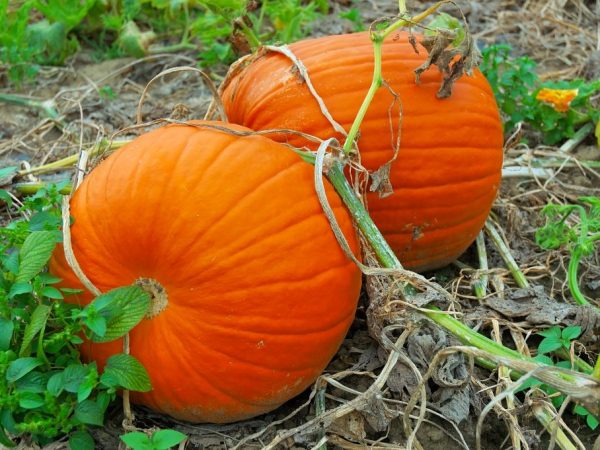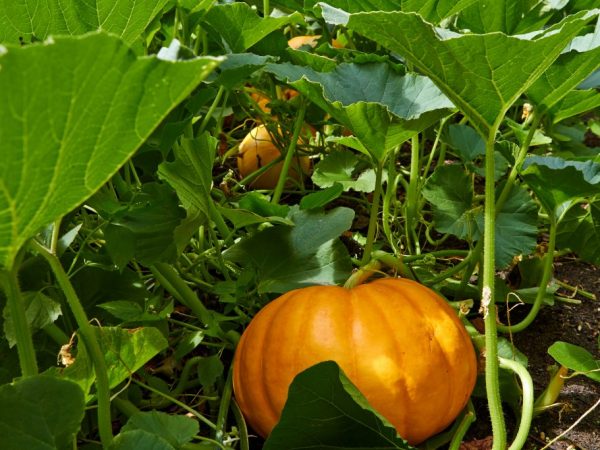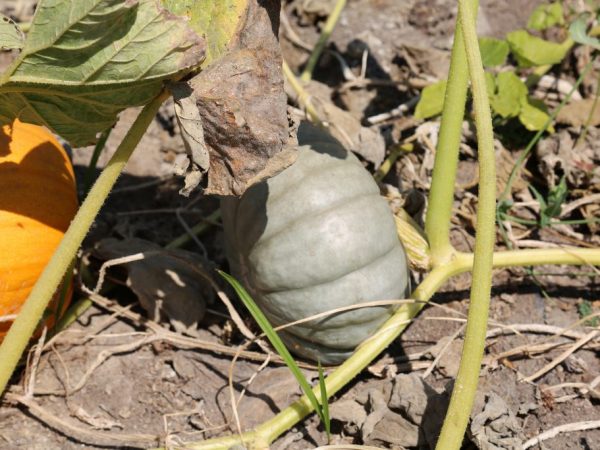Sweet pumpkin varieties and care
Sweet pumpkin varieties are loved by many gardeners. They have a pleasant taste, they can be added to cereals or simply boiled. Some varieties can be added raw to salads.
- Features of sweet varieties
- Popular sweet varieties
- Variety Pyshka
- Variety Sweet chamomile
- Chestnut variety
- Variety Honey dessert
- Variety Volzhskaya gray
- Variety Sweet winter
- Variety Yellow centner
- Variety Gribovsky
- Variety Parisian gold
- Growing pumpkin
- Soil preparation
- Seed preparation
- Landing
- Pumpkin care
- Diseases and pests
- Major diseases
- Major pests

Sweet pumpkin varieties and care
The culture is grown in the southern and temperate regions, but the more heat and sun it receives when ripe, the more sugar will be in the pulp.
Features of sweet varieties
There is no separate item “sweet” in the classification of pumpkin varieties. They are divided into:
- Hardcore
- Nutmeg
- Large-fruited
- Decorative
The latter are inedible, the fruits have a thick skin and dry pulp. But they are stored for a very long time, have an original shape and serve as an interior decoration.
Most often, the hard-bore pumpkin is a table, universal or forage crop. It has a thick woody rind. They do not deteriorate for a long time, they are stored for up to a year.
The sweetest varieties of pumpkin, nutmeg and large-fruited varieties. In some of them, the sugar content reaches 15%.
In this case, the calorie content of the product increases slightly. Butternut squash grows best in southern areas.
They have a thin peel, the inside is soft, rich orange hue. Juices, mousses, mashed potatoes are made from juicy fruits, they can even be eaten raw. Unfortunately, nutmeg species are stored for a short time, about 2-3 months.
Among the large-fruited species, there are real champions both in size and in sugar content. Some fruits are sweeter than watermelons.
They have an elongated or round shape, yellow or orange juicy crumb. The peel is of medium density, the fruits do not lose their qualities for a long time. Large-fruited grow well in temperate latitudes.
Popular sweet varieties
Sweet-fleshed pumpkins are high in sugar.
When choosing, you should look at the ripening time: it is advisable to choose mid-ripening or late-ripening. The early ones do not have time to accumulate enough simple carbohydrates in the pulp.
Be sure to find out what the yield, care features and shelf life are (nutmeg pumpkins are stored less, large-fruited ones can lie until spring).
Also find out if it is suitable for your climate zone. Keep in mind that varieties intended for the southern regions will not pick up the declared sugar content in mid-latitudes.
To choose the most suitable sweet pumpkin variety, you need to carefully read their description.
Variety Pyshka
The variety Butter Pyshka F1 is a hybrid bred in the USA. It ripens for 90-100 days. Type of fruits "acorn": they are ribbed, cream-colored with greenish stripes. The rind is thin but firm. The middle is bright orange, soft. The seed chamber is very small. A vegetable grows up to 7-8 kg, its taste is delicate and sweet. The sugar in the pulp is about 10%.
In warm regions, the variety is grown directly from seeds, planting them in the garden on the 10th of April.In the middle lane, it is advised to grow a crop from seedlings. The first shoots can be seen after 6-7 days, and in 2-3 weeks they are transferred to open soil.
Variety Sweet chamomile

The variety is versatile in preparation
Sweet chamomile has fruits weighing 3 kg to 8 kg. They are rounded, flattened at the poles, with well-defined ribbing. The skin is thin, but firm, with a bright orange color. The pulp is fleshy, thick (up to 10 cm), sweet in taste.
Pumpkin is normally transported, it is stored practically until spring. Suitable for cooking cereals, cooking candied fruits, baking, baby food.
Chamomile is well adapted to cool, dry climates. Sow it immediately into the open ground when it warms up to 10-12⁰С. The plant is long-leaved, therefore, after setting 3-4 fruits, it is recommended to pinch it. To increase the yield, mineral and organic dressings are applied 2-3 times per season.
Chestnut variety
F1 sweet chestnut is a hybrid with compact fruits (up to 600 g). From above, they are spotty, dark green, rounded, with poorly defined ribs. Pumpkin has a special starchy and sweet pulp.
After baking, it becomes crumbly, similar to edible chestnuts. It is recommended to stuff the fruits with porridge or fill the soufflé, and then bake them in the oven.
It is grown by seedlings. Seed shoots indoors, at a temperature of 20-30 20C, appear after 6-7 days. You need to plant plants in the garden at the age of 2-3 weeks. In the middle lane, the optimal time for transferring seedlings to open ground is mid-May, when there is no longer a threat of frost.
Variety Honey dessert
Honey dessert consists of large pumpkins with a characteristic tart honey flavor and aroma.
Climbing bushes, fruits are flat-round, with irregular ribs and large lobules. The rind and center are bright orange. The pulp is sweet, juicy and soft. The weight of the pumpkin is the largest among all types of honey.
They grow up to 6 kg, but there are also specimens of 10-11 kg, small heads of 3-4 kg are rare.
You can plant a vegetable both directly in the ground and for seedlings. The first option is suitable for warmer areas, the second for more northern regions. The variety needs constant feeding, regular watering, does not tolerate direct sunlight.
It is recommended to put planks, plywood or straw under large heads so that they do not rot. Pumpkin ripens in 95-100 days. With proper care, the yield reaches 10-12 kg / m².
Variety Volzhskaya gray
Volzhskaya gray is a fruitful variety with an average ripening period. Up to 15 kg of products are collected from one meter of the garden bed.
Ripening time - 3.5-4 months. The fruits are large, about 10-20 kg.
The shape is correct, rounded, the lobules are poorly expressed. The peel is uniformly gray in color, sometimes with a greenish tint. The middle is yellowish, with a sweet taste.
The seeds are large, occupy most of the pumpkin (flesh up to 5 cm). It is better to grow a plant from seedlings. Indoors, seeds are planted at the end of March, and the sprouts are transferred to the soil when it warms up well. The fruits ripen evenly and are well stored.
Variety Sweet winter

Fruits can be kept fresh until spring.
Sweet winter is a late-ripening variety that ripens 140-150 days after planting.
Fruits are round, slightly flattened at the ends, with moderately pronounced lobules. The skin is dark gray, elastic and firm.
The middle is dense, crunches, has a bright yellow-orange color, sweet taste (up to 11-12% sugar) and a lot of juice. In the shade and with too much watering, the sugar content drops.
Grow Sweet winter pumpkin from seedlings or directly from seeds in the beds. The harvest is harvested in the second half of September, the weight of the fruits by that time is 10-12 kg, up to 30 kg of products are obtained from a meter. Pumpkins are stored for a long time, almost until spring.
Variety Yellow centner
The most delicious sweet pumpkin variety is Yellow centner. The fruits weigh about 50 kg, and on good soil they can reach a mass of 100-200 kg.
Up to 5-7 pumpkins ripen on one bush.They are round, flattened at the ends, segmental structure. The skin and soft part are bright orange. The level of carotene and sugar in fruits breaks all records.
The seeds are large, up to 800 pieces are tied in one fruit. They can be planted in April for seedlings. At the end of spring, seeds can be sown directly into the ground. The vegetable ripens for 98-100 days. It is stored without loss for 4-6 months, often grown on an industrial scale, for sale or for feeding animals.
Variety Gribovsky
There are several subspecies of Gribovskaya pumpkin - hard-bark, winter and bush.
The hard-barked and bush fruits are ovoid or oval, weighing 3-5 kg. The peel is green at first, and turns yellow when ripe. Sometimes narrow green stripes remain. Both varieties ripen for 85-100 days.
Winter Gribovskaya has a flat-round shape, gray skin. The crop can only be harvested 140-150 days after planting.
The flesh of any Gribovskaya pumpkin is orange, juicy, elastic. It contains an increased amount of sugar - 8-12%. Fruits are stored for a long time, especially in the winter variety. You can plant seeds directly into the ground. The best dates are late spring or early summer (for winter - mid-May).
Variety Parisian gold
Parisian gold is a drought-resistant and mid-season hybrid. Fruits are large, round, 5-10 kg, with golden skin and orange flesh.
The taste is pleasant and sweet, the skin is easily removed. The pumpkin lies until the end of winter or early spring, it tolerates frost well. This variety is often used to prepare baby food.
You can plant seeds in the ground in the last decade of May, and for seedlings - from the beginning of April. Care is standard, the bushes should not be watered too abundantly. Fertilizers are applied 2-3 times per season. The crop appears 105-115 days after the appearance of the first shoots.
Growing pumpkin

Sweet varieties are popular
Mashed potatoes, baby food, candied fruits, jams are made from sweet pumpkin, so it is quite possible to start industrial cultivation of it.
the sweet varieties on the market are the most popular due to their pleasant taste, high sugar and carotene content.
In a small garden bed, you can grow so many fruits that a large family will eat them all winter.
Soil preparation
It is better to plant sweet pumpkins on the south side of the site. If it is a long-flowered curly variety, then it should be placed near a net or fence. The best predecessors are legumes, potatoes, onions, root vegetables, cabbage.
The vegetable loves fertile soil, grows poorly on clay and sand. If you have clay soil in your garden, compost should be added before planting in the garden, in a 1: 1 ratio to the base soil. To fluff the soil, peat or river sand is added to it.
Fertilizers are applied 2-3 weeks before planting (per m²):
- Superphosphate - 20 g
- Ammonium nitrate - 10 g
- Potassium - 10 g
- Ash - 250 g
For sandy soils you need:
- Humus - 0.5 buckets
- Superphosphate - 40 g
- Ash - 500 g
After making, the garden bed is dug so that the fertilizers mix well with the ground.
Seed preparation
The seed should be fresh, harvested last year. This primarily applies to hybrid varieties. For sowing, healthy seeds of approximately the same size are suitable. They should be soaked for 20 minutes in a weak pink solution of potassium permanganate for disinfection. Ready-made seeds from the factory do not need such processing.
For swelling, the material is immersed in warm water with a temperature of 50-60⁰С for 3 hours. The second option is to soak for 2-3 days in a warm place. Ash or growth stimulants, such as Epin, can be added to the water. Immediately before sowing, the seeds are dried a little in the air so that the peel is not slippery.
Landing
You can grow pumpkin directly in the open field or from seedlings. Indoors, seeds are planted in late March or early April.
Seedlings are grown in special peat or cardboard pots. The soil is taken universal, for vegetables. The soil is also prepared independently.
The following components are mixed:
- Peat - 2 parts
- Rotten sawdust - part 1
- Humus - part 1
- Nitrophoska - a teaspoon per 1 kg of substrate
For each plant, a separate container is allocated, measuring 6 × 6 cm. Seeds are planted to a depth of 1-2 cm, in moist soil. Until shoots appear, cover the pots with foil or glass. Water as the substrate dries.

After planting, the plants need to be watered
It is better to put a box with seedlings on the south window. 6-7 days after the emergence of seedlings, they are fed with nitrophos (1 tsp / 10 l of water). Plants are transferred to open ground when their height reaches 15-20 cm and 4-5 true sprouts appear.
On the garden bed, before planting, they dig holes 4 cm deep and the same in width. The distance between the holes should be 80-100 cm. The seedlings are lowered into the hole, sprinkled with earth and watered. Finished seeds are planted in the same holes. Sowing time is late May or early June.
Pumpkin care
To get a good harvest, sweet pumpkins need to be cared for properly. During the summer, they recommend:
- Feed the plants 2-3 times
- Water as the soil dries
- Loosen the ground
- Form bushes
The first feeding is carried out 7-10 days after the appearance of greenery (or 5-7 days after planting the seedlings. Mullein (1 liter per bucket of water) is best suited. A mixture of ammonium nitrate (3-5 g), superphosphate (5- 8 g) and potassium salt (3-5 g) The same fertilizers are applied a second time when the first flowers appear on the bush, the third time after a week and a half.
You need to water the pumpkin as the soil dries out, the culture does not like too wet soil. Before the leaves completely cover the ground, it must be loosened once a week. Curly varieties need to be directed to the supports. Be sure to control the number of ovaries, there should be no more than three of them on one branch. If there are many fruits, they will grow small and tasteless.
Diseases and pests
Diseases and pests can destroy the entire pumpkin crop. They need to be recognized in time and taken action.
Major diseases
- Bacteriosis Brown sores appear on the leaves and fruits, which over time completely destroy the plant.
- White rot. Caused by a fungus. White spots appear on all parts of the plant, then it begins to rot, the spots turn brown.
- Root rot. Characteristic brown constrictions appear on the roots and stems. The growth of the bush stops, the leaves turn yellow and fall off.
- Powdery mildew. The leaves are covered with a white coating, reminiscent of flour. First, small areas are affected, then the fungus covers all the green organs of the plant.
- Anthracosis or copperhead. Dark brown or black polygonal ulcers appear on the leaves.
Prophylaxis
For the prevention of diseases, seeds are treated with potassium permanganate before planting, soaked in zinc sulfate and special antifungal drugs. It is important to properly care for the pumpkin, not to water it too abundantly, to feed it on time.
You cannot plant a plant in the same place for 2-3 years in a row. If the disease has already arisen, the bushes are treated with copper sulfate, Bordeaux liquid, fungicides. The affected organs are removed and burned.
Major pests
- Spider mite. It settles on the lower surface of the leaves, hiding under a cobweb, which is easy to notice when examining the bush. Affected leaves acquire a mosaic color and dry out over time.
- Melon aphid. Small green insects occupying leaves and flowers. They suck the juices from the plant, which ultimately leads to its death.
- Sprout fly. insect larvae settle in the stems, which leads to the death of the entire bush.
Dichlorvos, karbofos, and other pesticides are used to control insects. Alternative methods are also effective - from manual removal of pests, to treatment with infusions of garlic and tobacco, and soap solutions.


